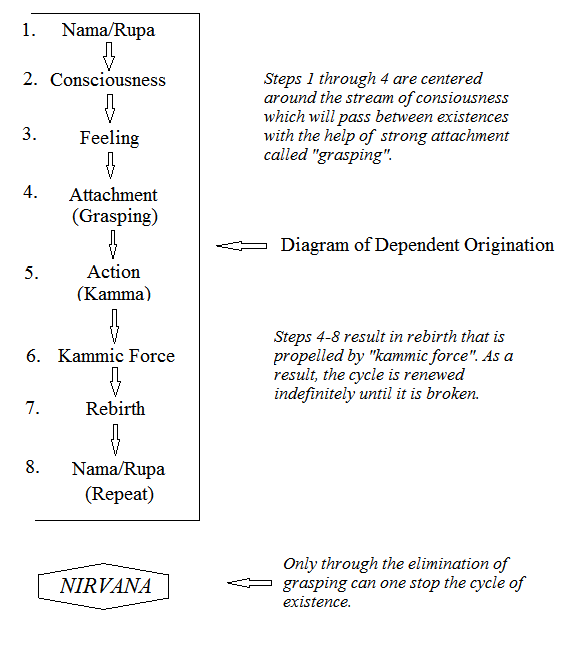It is common knowledge that Buddhists believe in reincarnation. Although this concept is rather simple, it is more complex then what most non-Buddhists would presume. To understand Buddhism one must understand the basics of reincarnation and how it works. If a person lacks knowledge of this most basic concept, Buddhism can raise more questions than it answers.
For example, how is it possible for the Buddhist concept of no-self to interact with the principle of reincarnation? This should create an insurmountable obstacle because karma cannot attach to an individual if there is no individual, self, soul, I or being. If so, how would reincarnation work properly? The answer is the “Law of Dependent Origination”.
The Elements of Dependent Origination

Dependent Origination Steps 1-4
A person or being only consists of mentality and physical form. The Pali terms for these concepts are nama (mentality) and rupa (physical form). This principle exists in all of the Buddhist realms in samsara. Whether it is the human realm, god realm, hungry ghost, animal realm or hell realms a being is merely a combination of nama and rupa. Essentially, there is no individual, self, soul or I. There is only the separate elements of nama and rupa.
Nama and rupa become interactive when a mental or physical object comes into the purview of one of the 6 sense doors. The sense doors are eyes, ears, nose, tongue, body and mind. A being becomes conscious of this internal or external object through sight, hearing, smell, taste, touch and thought. However, when these separate elements are received and interpreted they can be misconstrued as a person, self, soul or I.
When a person becomes conscious of an object it creates a feeling which is pleasant, painful or neutral. For example, if you see a pleasant sight you enjoy it and it creates a pleasant feeling. Therefore, you desire it and become attached to it e.g. passion, lust, love, greed. If you see an undesirable object then you feel repulsion towards it e.g. aversion, ill will, avoidance or even hatred. Although these forms of attachment seem like opposites, they are nonetheless forms of attachment/grasping. In sum, if the object is pleasant you desire to experience it again, if unpleasant you desire it to be replaced with a pleasant object. Either way, it still results in attachment.
When this desire becomes more intense, it becomes grasping. Grasping is the glue that forms the link between existences. This grasping is what the law of dependent origination revolves around. If it is eliminated, then the cycle of rebirth comes to a halt.
Dependent Origination Steps 4-8
“Kamma” is the Pali term for your actions. (FYI – “karma” is the more popular Sanskrit version of the word used by non-Buddhists.) Your actions are instigated because of the strong attachment mentioned above called grasping. For example, when your sense door consciousness instigates feelings of hunger, lust, love, hatred or greed you will act on these feelings. The resulting actions can be wholesome or unwholesome. Therefore, you will have generated either a good or bad kammic imprint.
This imprint is a powerful force that will propel your stream of consciousness between existences. Your condition of rebirth is based on the cumulative good and bad kamma you have generated in the previous existence. Deficits of good kamma can result in rebirth into a state of loss such as the animal or hell realms. On the other hand, if you have a surplus of good karma you can be reborn into the human or even the god realms.
After rebirth into a new realm, a being once again exists as nama and rupa. It is your stream of consciousness that will once again give rise to the 6 sense doors and you have begun a new existence. The cycle of dependent origination will repeat itself indefinitely until grasping can be eliminated.
What is Nirvana?
Nirvana is the Sanskrit equivalent of the Pali term “Nibbana”. Nibbana refers to the cessation of all suffering. Since Buddhists believe that all existence is suffering, Nibbana is the cessation of the cycle of dependent origination. Nibbana or enlightenment, is only possible through the generation of insight wisdom and the elimination of attachment.
Developing insight wisdom will allow sentient beings to eventually eliminate their ignorance about existence (suffering). Insight wisdom will weaken and ultimately extinguish attachment/grasping. If so, it is possible to break the cycle of rebirth in samsara.
The accumulation of insight wisdom is not possible through book knowledge and academic study. Therefore, one must follow the Eightfold Noble Path and use insight meditation to develop wisdom and eliminate ignorance. Only by applying the most arduous dedication can one obtain the ultimate goal of Nibbana. Theoretically it is possible in a single lifetime, but for many it can take thousands of lifetimes to achieve.
Source:
Talks on Meditation given in the Blue Mountains by Venerable Chanmyay Sayadaw


